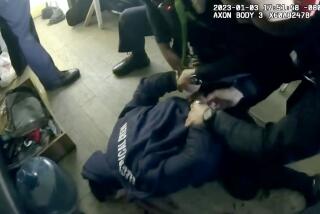Editorial: Raise the standard for police use of deadly force in California? Proceed with caution
A California lawmaker is trying to set a higher standard for when police may use deadly force, and that’s a welcome effort — not because it necessarily would have averted the fatal shooting of Stephon Clark or because it would allow more criminal prosecutions of police officers, but because it could accelerate the pace of improvement in police tactics and training that should, in turn, result in fewer unnecessary uses of force.
Sacramento officers shot Clark dead in his grandparents’ backyard on March 18, leaving him the latest in a string of high-profile fatal police shootings of unarmed African American men. The shootings are a continuing signal that something is seriously amiss in a public safety and criminal justice system that by rights should operate without regard to race and focus on preventing loss of life or injury.
The Clark killing forms the backdrop of a bill by Assemblywoman Shirley Weber, a San Diego Democrat, to allow officers to use deadly force only when it’s necessary to prevent imminent bodily injury or death.
That certainly sounds sensible. If that is not already the standard, one might wonder, what is?
California law parallels the minimal constitutional standard articulated by the U.S. Supreme Court in 1989: An officer may act in a way that is objectively reasonable for any officer to act under the circumstances. In practice, that somewhat tautological reasoning means that if officers encounter a man in a backyard at night holding something that could conceivably be believed to be a gun, even if in actuality it is a cellphone, and they believe they or others are in imminent danger — as the officers may have believed when they encountered Clark — they may use force. They may shoot.
Improving police conduct — and standards — often comes through much more mundane changes, such as training.
It is a standard that is meant to acknowledge the dangers faced by officers on the street and the split-second thinking required when they encounter potentially dangerous suspects. But critics complain that it’s a lowest-common-denominator norm. What is considered reasonable is determined by the actions taken by officers nationwide and the practices of their departments. Meet that standard, and no officer can be successfully charged with murder or excessive force for shooting or injuring a suspect.
Less often noted is that the objective reasonableness standard evolves, generally upward, over time. As police departments train officers in de-escalation tactics, and as they measure performance in ways that emphasize preservation of life over displays of force, those practices reset what can be considered objectively reasonable officer conduct. Not every “reasonable” police shooting in 1989 would be deemed reasonable today. Not every shooting today will be deemed reasonable next year, or the year after.
The pace of improvement, however, is too slow. No authority requires police departments to employ de-escalation training, for example. In 2016, the Police Executive Research Forum issued 30 guiding principles on uses of force, some of which were embraced by some police departments. But PERF has no power to impose those standards on local police.
So how can we speed up the toughening of use-of-force standards that guide court decisions on whether to hold police departments liable for unnecessary shootings, and whether to find the individual officers involved guilty of crimes?
One route is for states to enact stricter rules of police engagement into law. To date, individual police departments have done that, but not states.
Perhaps because the tragic and shocking Clark shooting was so recent — or perhaps because it follows so many other shootings of unarmed African American men — understandably angry protesters and distraught families see justice being served only if the officers are convicted of murder. And indeed, there may be times when criminal charges are fitting and proper.
But improving police conduct — and standards — often comes through much more mundane changes, such as training.
Besides, there is an important distinction between officers who in good faith use force in accordance with department standards and training that may be woefully behind the times, or officers who make tragic mistakes that should result in their losing their jobs, and officers who act so far outside what is either reasonable or necessary under the circumstances that they should be considered murderers.
The challenge for Weber and other California lawmakers is to craft language that effectively raises the standard of performance without needlessly endangering the lives of officers or putting them in such fear of being criminally charged that they are unable to carry out their duties. Such a bill would be worthy of support.
Follow the Opinion section on Twitter @latimesopinion and Facebook.
More to Read
A cure for the common opinion
Get thought-provoking perspectives with our weekly newsletter.
You may occasionally receive promotional content from the Los Angeles Times.






